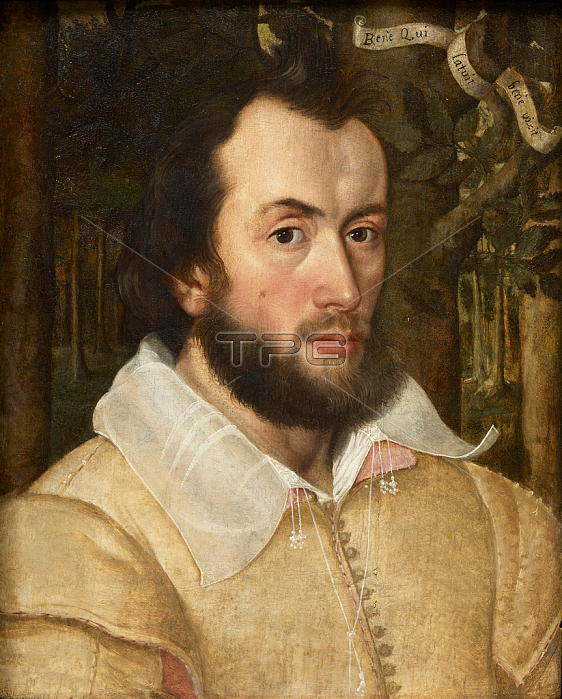
4073718 Portrait of a Gentleman, c.1600 (oil on panel) by English School, (17th century); 47x38 cm; Private Collection; (add.info.: This intensely lyrical portrayal of an unknown man goes to the heart of Elizabethan poetic and artistic sentiment. Fused into an arcadian sylvan setting with a transcribed quote from Ovid - the most studied and influential classical writer in Tudor England - this deeply arresting image toys with concepts of mortality, melancholy and idealistic commitment. To understand the popular depiction of melancholy in Elizabethan and Jacobean portraiture, one must first appreciate its social relevance. Melancholy was considered one of the four humours, and every man was thought to have an excess of one. Each are steeped in their own qualities and the most desirous is blood which equates to the humoral type of sanguine; it is hot and moist, the two physical qualities believed to sustain life. In contrast is melancholy, associated with the negative attributes of cold and dryness, and an individual who is melancholic is on the whole unhappy and unprepossessing. However, during the late fifteenth and early sixteenth centuries this humour was re-established in Italy as the fashionable physical affliction of the intellectual ??this quickly spread to England in the 1580s. Some of the most iconic Elizabethan portraits are those which engage in the fashionable melancholic state, one of the most remarkable being a portrait of Henry Percy, 9th Earl of Northumberland by Nicholas Hilliard painted c.1594-5. Percy is portrayed lying in an expansive landscape with his head resting on his hand, his loneliness reflecting the melancholic??? passion for solitude. Like the subject of the present work, Percy is shown in more informally attire with his collar open, as if romantically caught off guard. The inscription in the top right corner of this work, Bene Qui Latuit bene vixit, translates to roughly He who hid well, lived well, and is a quote from Ovid??? Tristea. This witty irony is typical of the Elizabethan period and often portraits would contain messages disguised by complex symbolism and wordplay. The inscription is painted on a white banner and wrapped around the branch of what appears to be a rowan tree, a species thought to provide protection from evil spirits. ); Photo byPhilip Mould Ltd, London.
| px | px | dpi | = | cm | x | cm | = | MB |
Details
Creative#:
TOP27627948
Source:
達志影像
Authorization Type:
RM
Release Information:
須由TPG 完整授權
Model Release:
No
Property Release:
No
Right to Privacy:
No
Same folder images:

 Loading
Loading